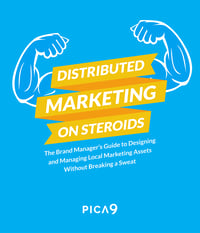In the rapidly evolving marketing landscape, companies of every size depend on design tools to produce captivating and brand-consistent content. CampaignDrive and Canva are two of the most favored tools, each catering to distinct needs and audiences. So, which one suits your business best? Let's explore both platforms to understand their differences.
| Feature/Aspect | CampaignDrive by Pica9 | Canva |
| Primary Purpose | Distributed/local marketing at scale |
General-purpose design tool |
| Target Users | Multi-location brands, franchisees, local marketers | Designers, marketers, individuals, small teams |
| Template Control | Locked templates with strict brand compliance | Flexible templates, looser brand control |
| User Experience | Enterprise-level, tailored for controlled workflows | Simple, intuitive drag-and-drop interface |
| Customization | Limited/local customization within brand guidelines | Full creative freedom |
| Brand Governance | Strong — ideal for regulated industries or strict branding | Moderate — brand kits help but are not foolproof |
| Asset Management | Built-in DAM, approval workflows, usage tracking | Basic soldering and content sharing |
| Pricing | Does pricing packages | Free to affordable subscription plans |
What is CampaignDrive?
CampaignDrive is a brand management and design platform tailored for businesses that need to maintain brand consistency across multiple locations, teams, or franchises. It’s an all-in-one tool that allows marketing teams to create, share, and manage templated designs without compromising the integrity of the brand.
Key Features:
- Brand templating system: Admins can design advanced print, digital, and HTML templates that are a breeze for End Users to easily customize while maintaining brand guidelines.
- Approval workflows: Ensure content goes through the correct approval channels before it’s published.
- Customizable databases: Templates will populate information like user, location, event, and product details.
- Multi-location and franchise support: Pica9 can act as a first line of support for your End User's questions and only escalate to your team when necessary.
What is Canva?
Canva is a graphic design tool aimed at simplifying design for everyone—whether you're a business owner, marketer, or someone who just wants to create a social media post. With its intuitive drag-and-drop interface, Canva makes it easy for users to design professional-looking materials without any prior graphic design experience.
Key Features:
- User-friendly interface: Simple, drag-and-drop design functionality that makes creating one-off graphics a breeze.
- Templates for every use: Canva offers a wide variety of unbranded templates for everything from social media posts to presentations and business cards.
- Extensive content library: A huge collection of stock images, fonts, icons, to be used in designs only.
Conclusion: Which One Should You Choose?
- Choose CampaignDrive if you’re part of a mid-to-large organization that needs to maintain strict brand consistency across multiple teams, locations, or franchises. It’s the ideal choice for businesses that require brand management and workflow automation.
- Choose Canva if you’re a small to mid-size business or an individual who needs a simple, affordable tool for creating a wide variety of marketing materials. Canva is perfect for non-designers and teams who want a lot of design flexibility and aren't as concerned about brand integrity.
Ultimately, the choice between CampaignDrive and Canva depends on your business size, needs, and budget. If you're focused on creating materials that adhere strictly to brand guidelines with a controlled, efficient process, CampaignDrive is a great option. If you need flexibility, ease of use, and collaboration with a lower cost of entry, Canva is likely the better fit.




